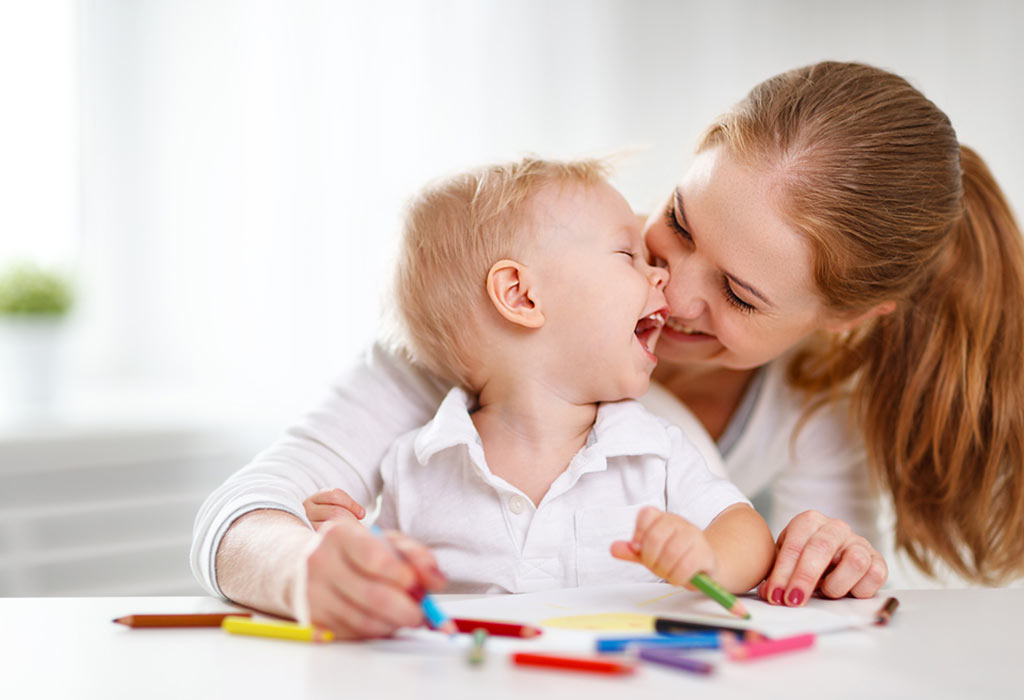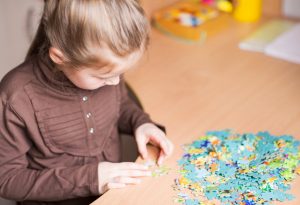In this Article
You can teach colours to kids through so many fun activities. Children begin to learn colours during their preschool years and their ability to identify colours is considered a milestone in their cognitive development. Being able to distinguish colours helps build the cognitive pathways between visual clues and words. Therefore, engaging with children in helping them learn colours is essential.
Why Teaching Colours to Toddlers Seems Complicated?
Your young one’s ability to recognise different colours begins to develop around when he is about 18 months old . At the same time, kids start to notice differences in shapes, texture, and size and pick up the similarities. Knowing primary colours takes longer, and most children by the age of 36 months can name at least one.
Before you can begin to teach colours to toddlers, it is crucial that you understand the learning process of toddlers and kids. Especially with abstract concepts such as colours, kids need to have accumulated a lot of information before they can understand what colours are. Before the concept of colour is understood, the learning might be as simple as blue is blue. Kids cannot understand that different shades of blue are all still blue such as light blue and navy blue. Neither do they have the verbal skills to explain the difference.
As they begin learning what each colour is called, they also need to understand what each colour represents.
For example, if you show them a green apple and say the colour is green, the child may associate the shape of an apple with the word green and may remember it as such. Therefore, you will also have to show them an apple that is not green, so it can act as a negative example to show the difference. With more examples which show that green is not the shape, not the size, not the texture and not the name of an object, they can grasp what is green. Therefore, every time you show them something green, but with a different quality to it, their understanding of the concept gets refined. Although it takes time, teaching colours can be easy as you can use everyday objects and different images to teach your kids all about colours.

How to Teach Colours With Everyday Activities
Teaching colours during everyday activities and routine is the best way to reinforce the concept of colours that is taught to them in their preschools. Children have a natural affinity toward brightly coloured objects; hence most of their toys are strikingly colourful. When you show them, say, a ball, using the word “colour” along with the name of the object is a good way to begin. Instead of saying ‘this is red’, the better approach would be to say ‘this is a ball, and its colour is red’. The same can be done with different coloured balls.
It should also be noted that receptive language in kids develops earlier than expressive language. They would be able to point at a colour long before they can say its name. Therefore, during playtime, you could ask them to pick up all the pieces of a colour and put them together. It helps to stick to the primary colours – red, yellow, blue, black and white. You can add other colours later on. Dedicating time to each colour separately is a good way to teach the concept. Having a “green week” or a “yellow week” works very well in understanding colours over time; you could wear identical coloured clothes or paint everything in the same colour or use toys with a specific colour every week. Children are experiential learners; therefore if they are taught to explore colours through all their senses such as sight, smell, sound, taste, and touch, they will learn better.
10 Easy Ways to Teach Colours to Pre-Schoolers
1. Modelling Clay
Activities involving modelling clay is a great tool to teach colours in kindergarten. Modelling clay is highly engaging while being endlessly fun. Children can learn how to recognise colours and build different things out of the same colour, or they can mix colours to see what they get.
2. Colour Matching Games
Colour matching games are a good way of teaching primary colours to preschoolers. You can make coloured cards out of any cardboard and place them on the floor or table. The game is to pick up matching colours. The same can be done with coloured blocks or balls with each day dedicated to a different colour.
3. Finger Painting
Finger painting is an immensely fun and great activity to teach colours to 3-year-olds. Children of that age are old enough to paint with colours, and you can start with one colour every day. The activity would be to let them have fun colouring while they tell you what colour it is.
4. I Spy Game
Play the “I Spy” game around the house and let the kids find objects of different colours. You can also play this game with an “I Spy” book that has different coloured papers pasted on different pages, and the kids can look for them.
5. Colour Jigsaw Puzzle
Make a simple jig-saw puzzle out of cardboard strips of the same colour and let the kids pick up similar colour and put them all together.

6. Treasure Hunt
Hide a differently coloured object in a playing pit and let the kids dig out blocks of the same colour. Alternatively, you can use a bucket filled with sand to hide smaller coloured blocks.
7. Colour Fishing Game
Take cardboard sheets of different colours and cut out fish shapes. Stick a magnetic strip on their backs and use a stick with a string and a magnet attached at the end that the kids can use as a fishing rod. The game is to catch fish of the same colour.
8. Colouring Books
Colouring in books is the simplest way to get them to learn colours. Ask them what colour crayon they are using for each page.
9. Colour Days
Wear the same colour shirts on different days of the week. Monday could be yellow, Tuesday could be red, Wednesday can be green and so on. On those days, play with toys of the colour of the day.
10. Ribbon Dancing
Coloured streamers are available at party stores and are excellent for a ribbon dancing activity. Let the kids have fun dancing with their coloured streamer.
These activities will help you teach your child about different colours in a fun way. First, familiarise him with bright colours, as kids have a natural affinity towards anything bright and shiny, then teach your child about other colours. Try to use everyday objects to reinforce the concept of colours in your child, as it will help him learn about different colours, as well as various shapes and sizes. Apart from teaching him about colours, focus on improving his other skills, too. Get your hands-on educational kits to promote overall intelligence of your child. The activities in these kits will help him work and hone his other talents, and every day he will learn something new.









